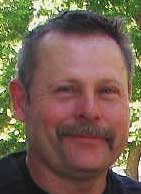 While watching Paul Ahrens gently and efficiently shear sheep and patiently answer questions about what he is doing, a person would never guess he was formerly a National Guard First Sergeant serving in Iraq. In 2003 he was injured by shrapnel in the back of his legs and spent almost two years recovering. He gives credit to his physical therapists. “Those folks are hard on you but it is worth it to be able to walk again.” Ahrens was not able to shear at all in 2004, but has been back to the job he loves for three years now – shearing sheep around the nation.
While watching Paul Ahrens gently and efficiently shear sheep and patiently answer questions about what he is doing, a person would never guess he was formerly a National Guard First Sergeant serving in Iraq. In 2003 he was injured by shrapnel in the back of his legs and spent almost two years recovering. He gives credit to his physical therapists. “Those folks are hard on you but it is worth it to be able to walk again.” Ahrens was not able to shear at all in 2004, but has been back to the job he loves for three years now – shearing sheep around the nation.
Based in Lamar, Ark., Ahrens spends January through June shearing sheep for growers with anywhere from five to 5,000 sheep. Many of the ranches in New Mexico and Texas keep him busy before lambing season. Sheep are easier to shear before they lamb and lose body condition during lactation, plus the new lambs won’t be tempted to suck on wool instead of a teat. Lamb feedlots take up the fall portion of the year. But on a beautiful May Saturday when other men are mowing their yards, Paul is giving a demonstration of shearing to interested spectators at the Prairie Grove Battlefield for the Wool and Wheel spinners guild. As Paul shears six sheep, guild members take wool and show local children how to card, spin and weave it. Paul took time out of a full schedule of shearing so that area children could watch him work.
Prairie Grove shepherds Ken and Linda Coffey donated the Gulf Coast sheep for the demonstration and provided information to the audience. Gulf Coast sheep are an extremely rare native breed of sheep, known for their resistance to internal parasites. After lunch Paul will relocate to finish the Coffey’s remaining sheep and spend the rest of the day with other nearby flocks needing his assistance. Linda Coffey commented on Paul’s ease of handling the sheep, and said, “He never cuts the sheep, and the sheep respect his confidence.” Small holders of sheep in Arkansas really appreciate his caring but businesslike attitude.
Ahrens enjoys being paid for a quality service. “This job is not like hourly work, we get paid per head. When you're looking at 5,000 sheep, it’s best to work together and do an efficient job,” he said. Ahrens and five other shearers travel together to tackle the big ranch and feedlot jobs, and Paul said he can handle 200 head per day. While he doesn’t mind small jobs of two or three sheep, he likes to see the community work together and congregate the sheep at one farm. This saves time because setting up his equipment in one place is more convenient, and in addition he is able to give a more affordable service. Many times the county extension agents will schedule a shearing day at the fairgrounds.
Ahrens gives counsel to make shearing days better for all concerned, including the sheep. “Sometimes the mats in the wool catch the skin and a sheep gets nicked. Lanolin is a powerful healing agent. Wounds are best left alone. In two to three days they will be almost healed,” Paul said. He also encourages producers to deworm the sheep well before shearing day because thin sheep are more likely to be injured during shearing. Other routine procedures such as hoof trimming should also be done at a another time to reduce flock stress. He stresses the importance of the sheep being kept dry before shearing. He prefers them to be dry and off feed and water overnight. Sheep with full bellies are uncomfortable being rolled on their backs.
Ahrens provides further service to his farm customers by storing and wholesaling their wool. An old broiler house on his home ranch protects the bags of wool until an Illinois company sends a semi-trailer to pick it up and purchase it. The wool checks go directly to the grower. Ahrens hopes this service will encourage more small flocks to continue in production, because rising production costs effect the small flock holders more seriously.







